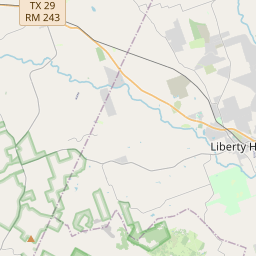Liberty Hill Cemetery
Historical marker location:






Weathered gravestones show usage of this spot for burials since 1852, when the earliest settlers were establishing homes in area. The first formal grant of land here as a community burial ground was made by John T. and Amelia Edwards Bryson in 1875, when three and one-half acres were deeded to the Liberty Hill cemetery trustees: T. N. Bryson, C. C. Chance, W. H. Poole, J. B. Roddy, and T. S. Snyder. This acreage was protected by a stone fence built with their own hands by the Brysons and their neighbors. Additions to original plot include land formerly owned by John T. Bryson and donated by Dr. and Mrs. H. L. Fowler. Royal Arch Masons in 1932 established an adjacent three-acre Masonic cemetery, later transferring title to the Liberty Hill Lodge No. 432, A.F. & A.M., which gave it in 1959 to the Liberty Hill Cemetery Association.
By later land purchases, the cemetery now contains more than twenty acres. Funds have come by bequests from Walter Gardner, Arthur Gray, and T. L. McDaniel. Many other persons have also contributed to funds for the cemetery. In 1953 the Liberty Hill Cemetery Association was incorporated, with Dr. J. Gordon Bryson as president; C. L. Chance, vice president; C. F. Hickman, treasurer; and Mrs. Letitia Russell, secretary
As one of the most visible programs of the Texas Historical Commission (THC), historical markers commemorate diverse topics in Texas history, including: the history and architecture of houses, commercial and public buildings, religious congregations, and military sites; events that changed the course of local and state history; and individuals who have made lasting contributions to the state, community organizations, and businesses.
More history nearby
The state of Texas was once an independent country known as the Republic of Texas. It gained independence from Mexico in 1836 and was a separate nation until it was annexed by the United States in 1845.
The region was first settled by European pioneers in the mid-19th century. The establishment of Fort Tumlinson in 1839 provided protection to settlers, and the population grew steadily with the arrival of more immigrants in search of new opportunities. In 1848, the county was officially organized and named after Robert McAlpin Williamson, a judge and soldier in the Republic of Texas.
During the Civil War, Williamson County faced significant challenges. Many residents joined the Confederate Army, and the county became a hotbed of conflict due to its location on the frontier between Union and Confederate territories. After the war, the area was able to rebuild and experienced a period of economic growth, driven by agriculture, cattle ranching, and the emergence of small towns and rural communities.
In the 20th century, Williamson County continued to develop and adapt to changing times. The discovery of oil in the early 1900s brought economic prosperity to the region, and the county experienced a boom in population and infrastructure. Today, Williamson County is a thriving part of the greater Austin metropolitan area, known for its strong economy, vibrant communities, and commitment to preserving its historical roots.
Williamson County Timeline
This timeline provides a concise overview of the key events in the history of Williamson County, Texas.
- 1804 - The area that is now Williamson County is settled by Native American tribes, including the Tonkawa, Lipan Apache, and Comanche.
- 1836 - Texas gains independence from Mexico.
- 1838 - The Texas legislature establishes Williamson County, named after Robert McAlpin Williamson, a leader in the fight for Texas independence.
- 1848 - The Mexican-American War ends and the Treaty of Guadalupe Hidalgo is signed, officially establishing the Rio Grande as the boundary between Texas and Mexico.
- 1850 - The population of the county reaches 1,027.
- 1876 - The Texas State Capitol building is completed in Austin, which becomes the seat of government for Williamson County.
- 1881 - The International-Great Northern Railroad reaches Georgetown, bringing economic growth and development to the county.
- 1907 - The county courthouse, located in Georgetown, is completed.
- 1930s - The Great Depression hits Williamson County, causing a decline in the local economy.
- 1950s - The county experiences a period of growth and prosperity, with the population increasing significantly.
- 1990s - Development and suburbanization accelerate in Williamson County, with the county becoming one of the fastest-growing areas in the United States.